Apples – to your taste
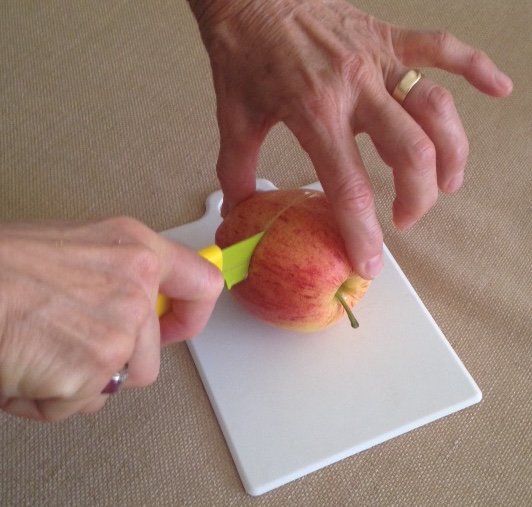
I was asked by a teacher recently, what is an activity that I particularly like to do with my preschoolers in the fall. Not too surprisingly, apples came to mind.
I have taught decades of preschool classes in Minnesota and Arizona. In Minnesota — and I would guess pretty much anywhere in the Temperate Zone – autumn is apple season and you shouldn’t have to go too far to find a farm stand, a pick-your-own apple orchard, or grocery shelves full of multiple kinds and colors of apples. Even in southern Arizona.
I know, it’s OCTOBER 1st. You are probably already thinking about pumpkins. If you’re a teacher, you’re probably tired of your apple songs, apple math activities, and you’ve already read all the apple books. Maybe you’ve already made apple dumplings and apple pie. OK, I’m late with this. So save it for next year.
Or… Maybe I’ve done something a little differently that gives you a new idea, or at least reminds you of an old one. Or if you’re a parent with young ones at home, this is totally do-able in your own kitchen. Read on, apple lovers.
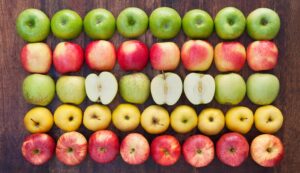 Credit: Patrizia Savarese/Getty Images, from AARP.org website
Credit: Patrizia Savarese/Getty Images, from AARP.org website
https://www.aarp.org/health/healthy-living/info-2017/eating-apples-healthy-benefits-fd.html
In the U.S., at least, most children have been eating applesauce before they had teeth. Some have experienced the smells and tastes of home-cooked applesauce made from a variety of apples. If applesauce no longer excites them, they are very likely still fans of apple juice. But now, at preschool age, they have strong chewing teeth, and so they are either enjoying fresh apples or they are ready to give them a try. So in the fall, in my classes, we do an APPLE TASTING activity.
“How would you like to do an apple taste test and decide which is the tastiest?” I ask.
Whether at home in your kitchen, or in the classroom, this is an almost irresistible invitation.
Background: As a teacher of young children, I consider my role to be an “instigator” and a guide. I have been fortunate to work at schools where we are supported in creating interactive classrooms, encouraging the children’s participation, conversation, curiosity, questioning, investigation, problem-solving, planning, cooperation, self-expression, and celebration.
For the Apple Tasting activity, I use the ideas below as a framework, with the understanding that they may take different forms and directions, and the children’s interests and curiosity will be my guide. So here is how we go about it.
This might be a one, two, or three-day activity.
Depending on the ages and stages of the children, there are a lot of options. We choose the ones that are of most interest and at appropriate skill levels and attention span for this set of students each year. In fact, in a multiage classroom, or one with varied developmental levels (and what home or classroom isn’t?), the process may be modified for groups of students or individual children.
Introduction/discussion: We all have different tastes and preferences, which are all valid. Often our tastes and preferences change as we grow (or they change when we taste something again), so let’s explore what they are.
Getting the apples: Teachers and families are invited to bring in samples of as many different kinds and colors of apples as we can find.
Prep: We decide what we want to find out. Usually, first, it’s which apple(s) we like the best. Or maybe: are they sweet or juicy or crispy or tart? We create a graph or a chart showing each kind of apple.
FOR EXAMPLE: We might create an APPLE GRAPH that has columns divided by apple color, apple names, or descriptions. If we only have 2 or 3 types of apples, we might make a large VENN DIAGRAM, so that we can show similarities and differences in the apples’ characteristics, or chart each student’s favorite apple, and use the overlapping spaces for those who like 2 or 3 of them equally.
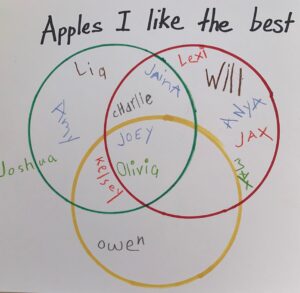 Joshua only liked the green apple … a little.
Joshua only liked the green apple … a little.
Tasting: We wash, slice, and give everyone a chance to taste one apple at a time.
Evaluating: We each have a chance to describe the taste (using adjectives), or to say I love / I like / I am not sure / I don’t like this one. [personal preferences, participating in a group, language]
Recording: After trying each apple, students (or teachers) mark the chart with a red, green, or yellow apple shape, or a crayon color, or an X, or writing their name or a word in the appropriate column or space. [graphing]
Results: We review and comment on the chart. [counting, comparing, reading, evaluating]
Follow up: Some students might make their own representation (picture and description, using invented spelling) of one or more apples. This could become a class book for the reading area or posters for the dramatic play grocery store, a bulletin board, etc. [small motor, literacy, self-expression, initiating and completing a task]
This is always a fall favorite, and it often leads to other taste comparisons later in the year.
Oh, but wait… Do you have apples left over? Get the children involved in helping you to make some applesauce! Will you include different types of apples? Can they help peel or cut them? Will you strain it or puree it or leave it lumpy? Will you add cinnamon or sugar or lemon or berries? (Reminder: Is anyone allergic to any ingredients?)
And one more thing …
“The Little Red House With No Doors and No Windows and a Star Inside” Do you know this story? ? (I talked about this story back in 2016, but it’s worth mentioning again.) There are many versions, and you can easily paraphrase it to tell in your own words. You can find it online, for example, here:
https://www.kinderteacher.com/LittleRedHouse.htm
or here: https://tickledpinkinprimary.com/2016/09/the-little-red-house-story-freebie.html
At some point, connected with our apple tasting, or at lunchtime, I will casually tell this story. IMPORTANT: Keep the red apple, the cutting board, and the knife out of sight until the appropriate moment at the end! Invite the children to react, guess, or predict before you reveal, or cut, the apple.
Show the open apple and ask (don’t tell) what they see!
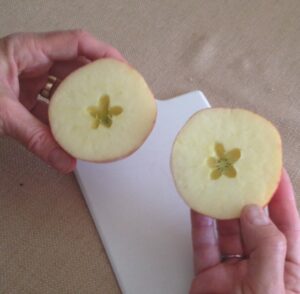 (Remember to cut the apple cross-wise, half-way between the top and bottom.)
(Remember to cut the apple cross-wise, half-way between the top and bottom.)
This story delights preschoolers! Several years, in a classroom where I ate lunch with my students daily, they would ask me, every day for months afterward, if I brought an apple for lunch. If I did, they begged me to cut it open so they could see if it had a star!

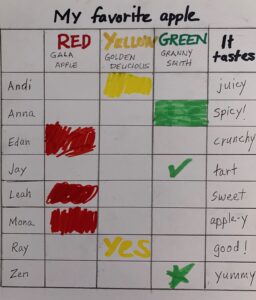
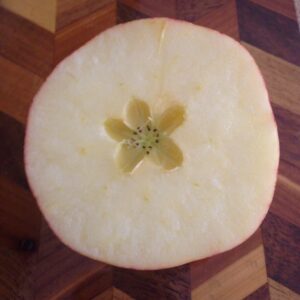
Leave a Reply